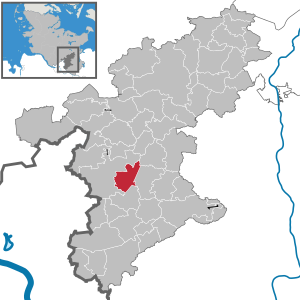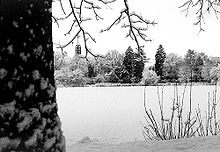Großhansdorf
| coat of arms | Germany map | |
|---|---|---|

|
Coordinates: 53 ° 40 ′ N , 10 ° 17 ′ E |
|
| Basic data | ||
| State : | Schleswig-Holstein | |
| Circle : | Stormarn | |
| Height : | 46 m above sea level NHN | |
| Area : | 11.2 km 2 | |
| Residents: | 9366 (Dec. 31, 2019) | |
| Population density : | 836 inhabitants per km 2 | |
| Postal code : | 22927 | |
| Area code : | 04102 | |
| License plate : | OD | |
| Community key : | 01 0 62 023 | |
| Address of the municipal administration: |
Barkholt 64 22927 Großhansdorf |
|
| Website : | ||
| Mayor : | Janhinnerk Voss (independent) | |
| Location of the community Großhansdorf in the Stormarn district | ||
The forest community of Großhansdorf ( Groothansdborough in Low German ) is located in the Hamburg metropolitan region and is in fact part of the Hamburg metropolitan area . The 9,000-inhabitant town is located in the Stormarn district in Schleswig-Holstein in the immediate vicinity of Ahrensburg .
history
Großhansdorf is mentioned for the first time in 1274 in a document from the Hamburg Katharinen parish, to which it belonged at the time. In 1435 the Hanseatic city also came under constitutional law. In 1642 a water mill was built, which was in operation until the 19th century. Since 1701, Großhansdorf was the seat of a Hamburg "Waldreiters" , an officer of the police authority. The coupling was completed in 1806.
The first written mention of the current district of Schmalenbeck dates back to 1314. Since 1444 it has belonged to Hamburg . The “Smale Beeke” (narrow brook) flowed from the underground village pond “Groten Diek” (there is a street of the same name). At least until the unification of the two communities in 1872, the Viebach essentially formed the border between Großhansdorf and Schmalenbeck. The Gasthaus Dunker was located on the mill pond in Schmalenbeck.
Groß-Hansdorf and Schmalenbeck were merged into one municipality in 1872, which was called "Groß-Hansdorf-Schmalenbeck". The Walddörferbahn - today the U1 underground line - has been connecting Großhansdorf with Hamburg since 1921 . Until the Groß-Hamburg-Gesetz of 1937, the districts Groß-Hansdorf and Schmalenbeck formed a municipality in the northeast of Hamburg, which belonged with others as an exclave to the Hamburg state (so-called Hamburg forest villages ). On April 1, 1937, Groß-Hansdorf and Schmalenbeck were transferred to the then Prussian Schleswig-Holstein by the Groß-Hamburg law . The community had now changed to the Stormarn district in 1937 and was assigned to the Ahrensburg district for about 1½ years in 1949 (see below). Over the years, the name Großhansdorf has become commonplace for the entire community, so the addition Schmalenbeck has been dropped in linguistic usage.
Kiekut is an area of the Schmalenbeck district that is not clearly defined by the population. It got its name from a former restaurant on the road to the church village Siek (today's name 'Wöhrendamm'). Since the landlord kept looking out of the window to see if one of the few guests was coming by, the citizens spoke of the "Kiekut tavern". The location of the inn can best be identified with a point behind the property: there the underground line goes from the cut to the embankment.
The wooden observation tower built before the First World War on the terminal moraine ( 70 m above sea level ) next to the later stop, which was already dilapidated before the Second World War and then collapsed after this, was not named after it. Nevertheless, the citizens speak of the "Kiekutberg". The concrete foundations of the tower still exist today. After all, the underground station built next to it was given the succinct name “Kiekut” instead of the originally intended name “Schmalenbeck-Ost”. The Großhansdorf town hall with the Waldreitersaal and the Catholic Church are located in this area today.
After the Second World War, the community was officially called Großhansdorf, while Schmalenbeck is still referred to as a district. About 60% of the inhabitants live in the district of Schmalenbeck and about 40% in the district of Großhansdorf (unofficially called Alt-Großhansdorf). After the destruction of Hamburg in the Second World War, wealthy entrepreneurs moved their residence to Großhansdorf. Großhansdorf has been an unofficial community since 1951.
Incorporations
On January 1, 1980, part of the neighboring municipality of Siek , which had about 50 inhabitants at that time, was incorporated.
Population development
| year | 1811 | 1910 | 1933 | 2002 | 2005 | 2016 |
|---|---|---|---|---|---|---|
| Residents | 250 | 591 | 1633 | 8987 | 9242 | 9355 |
politics
Municipal council and mayor
Großhansdorf was ruled by an absolute CDU majority for decades . In the local elections on May 25, 2008, the party lost its absolute majority, but remained the strongest faction in the local council.
The local election on May 6, 2018 , with a turnout of 54.5% (2013: 53.7%), led to the following result:
| Political party | Share of votes | +/-% p | Seats | +/- |
| CDU | 39.3% | - 6.7 | 10 | ± 0 |
| SPD | 19.2% | - 4.2 | 5 | ± 0 |
| GREEN | 27.9% | + 4.2 | 7th | + 2 |
| FDP | 13.6% | + 5.7 | 3 | + 1 |
The directly elected mayor is Janhinnerk Voss (non-party; last re-elected in September 2019).
coat of arms
Blazon : "In green on a golden three-mountain, which is traversed by a blue wave bar, a silver rider in the costume of the 16th century on a silver horse."
Town twinning
Ticino in Mecklenburg-Western Pomerania is twin town of Großhansdorf.
Economy and Infrastructure
Companies
At the Großhansdorf underground station there is a larger business district in Eilbergweg, a smaller one at the Schmalenbeck underground station and an even smaller one at the Kiekut underground station opposite the town hall. All trades serve almost exclusively to supply their own population.
There are two hospitals in Großhansdorf: The Park-Klinik Manhagen (arthroscopic and endoprosthetic surgery on the knee and hip) and the LungenClinic Großhansdorf , which has a very good reputation in the fields of pulmonology and especially thoracic surgery and is internationally known. The hospital was founded as a rehab facility for people suffering from tuberculosis. It has been assigned to the University of Lübeck for some time.
The Großhansdorfer Werk of Hamburger Wasserwerke (HWW) supplies not only Hamburg itself but also the Hanseatic City of Lübeck with drinking water.
education
Großhansdorf has had a community library since 1906, which is now located in the Schmalenbeck district.
Both districts have a primary school each, the main school area of the primary and secondary school in Schmalenbeck was closed on August 1, 2008 due to insufficient student numbers. The Friedrich Junge School and the Emil-von-Behring grammar school (around 770 students, as of 2003) are still located in the school center in Schmalenbeck . The EvB has existed since August 1st, 1967 and is one of 28 European schools in Schleswig-Holstein.
The Thünen Institute of Forest Genetics is located on the former Tannenhöft country estate of the ship owner George Henry Lütgens . Today's arboretum of the institute was built at the beginning of the 20th century by the garden architect Rudolph Jürgens as a park for Mr. Henry Lütgens, Gr. Hansdorf designed.
traffic
The place is on the federal highway 1 between the Bargteheide junction and the Stapelfeld junction. From the exit it goes either directly to the district of Schmalenbeck or via a bypass road to the city of Ahrensburg .
Großhansdorf is served by bus lines and the subway of the Hamburger Verkehrsverbund (HVV), the U1 line (blue) has its terminus in Großhansdorf. There are a total of three stations in the municipality: Schmalenbeck , Kiekut and Großhansdorf . The journey from Großhansdorf to Hamburg Central Station takes 43 minutes. A fourth stop, Beimoor, was under construction both during the First World War and shortly thereafter and was largely completed. The only thing missing from the double-track line and the sidings was the power rail when the project was abandoned immediately after the First World War, as was the planning of an armaments factory in the Beimoorwald.
Before the Second World War , the Hitler Youth practiced blasting, so that there is almost nothing left of the station building and nothing at all of the platform roof. Bats nest in the access tunnel, which has been partially buried and provided with a wall (with a door and an entrance hole) by the municipal administration. The slightly weathered platform for the four-car trains planned for the Walddörferbahn at that time is still fully preserved. Before the line was inaugurated in November 1921, the second track from Großhansdorf to the hall of the Volksdorf train station had also been removed; only in Schmalenbeck was there a passing point with the only two switches on the whole route. Only later did the Volksdorf - Buchenkamp section on the Hamburg state territory have its second track again, as did the Großhansdorf station with track 2 and its two sidings. After the Second World War, the current status was achieved with the construction of the passing point in Ahrensburg West station; the 20-minute intervals (in the morning and evening even 2½ hours at 10-minute intervals) made construction necessary.
Culture and sights
The list of cultural monuments in Großhansdorf includes the cultural monuments entered in the list of monuments of Schleswig-Holstein.
Personalities
- Claus Hinrich Witten (1811–1877), mill owner, farmer and governor in Schmalenbeck
- Hans Reimann (1889–1969), humorous writer, playwright and screenwriter, lived and died in Schmalenbeck
- Paul Brock (1900–1986), East Prussian writer, lived in Großhansdorf since 1953
- Siegfried Assmann (* 1925), painter, sculptor and draftsman, lives and works in Großhansdorf
- Fabian Harloff (* 1970), actor, radio play speaker, voice actor and musician, comes from Großhansdorf
- Carsten Herbert Spengemann (* 1972), actor and television presenter, his parents' house is in Großhansdorf
Web links
Individual evidence
- ↑ North Statistics Office - Population of the municipalities in Schleswig-Holstein 4th quarter 2019 (XLSX file) (update based on the 2011 census) ( help on this ).
- ↑ Schleswig-Holstein topography. Vol. 4: Groß Sarau - Holstenniendorf . 1st edition Flying-Kiwi-Verl. Junge, Flensburg 2004, ISBN 978-3-926055-75-0 , p. 32 ( dnb.de [accessed on May 1, 2020]).
- ^ Federal Statistical Office (ed.): Historical municipality directory for the Federal Republic of Germany. Name, border and key number changes for municipalities, counties and administrative districts from May 27, 1970 to December 31, 1982 . W. Kohlhammer GmbH, Stuttgart / Mainz 1983, ISBN 3-17-003263-1 , p. 187 .
- ↑ Result of the 2018 local elections , accessed on August 14, 2018
- ↑ Schleswig-Holstein's municipal coat of arms
- ↑ Facts about the Großhansdorf waterworks
- ^ Ingrid A. Schubert: Tannenhöft - garden artwork and arboretum . In: M. Liesebach, BR Stephan (Ed.): Tannenhöft - 90 years of the Arboretum - 50 years of the Institute for Forest Genetics and Forest Plant Breeding . Federal Research Center for Forestry and Wood Management, Hamburg 1998, PDF , accessed on February 3, 2016.
- ^ JF Voigt: The Hamburg rural community Groß Hansdorf-Schmalenbeck . Otto Meißner, Hamburg 1906, p. 67-68 .
- ^ Claas Greite: Ahrensburg celebrates with its local heroes. In: Hamburger Abendblatt. Retrieved January 27, 2015 .
- ↑ Jan-Eric Lindner: Spengemann: House of parents searched. In: Hamburger Abendblatt. June 13, 2003, accessed January 27, 2015 .




